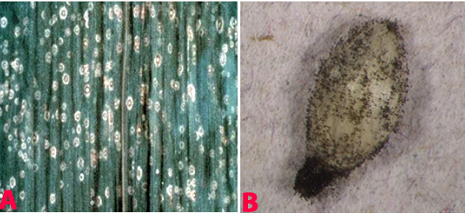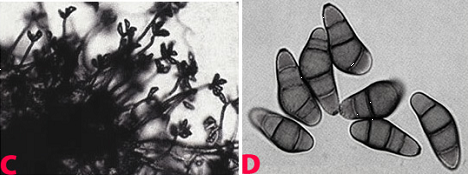Fungi - finger millet
Contributors to this page: ICRISAT, Patancheru, India (RP Thakur, AG Girish, VP Rao).
Leaf spot; Black kernel
Scientific name
Cochliobolus lunatus RR Nelson & Haasis.
Other scientific names
Acrothecium lunatum, Curvularia lunata, Curvularia lunata var. lunata, Pseudocochliobolus lunatus.
Importance
High
Significance
Less important in finger millet compared to sorghum.
Symptoms
Leaf spots occur on leaves as small, diffuse, and reddish with grayish centers (Shaw 1921).
Hosts
Poaceae (cereals), Oryza sativa (rice), Pennisetum glaucum (pearl millet), Sorghum bicolor (common sorghum), Zea mays (maize), Eleusine coracana (finger millet), Setaria italica (foxtail millet) and several leguminaceous crops.
Geographic distribution
The pathogen is widely distributed in Europe, Asia and Africa.
Biology and transmission
Colonies are effuse, brown, blackish brown or black, hairy or velvety. Conidiophores are solitary or in small groups, simple or branched, straight or flexuous, sometimes geniculate, pale to dark brown, septate, up to 650 µm long, 5-9 µm wide, often swollen at the base to 10-15 µm. Conidia are acropleurogenous, 3-septate, almost always curved at the third cell from the base, which is usually longer and often darker than the others. Cells at each end are sub hyaline or pale brown while intermediate cells are mid to dark brown, smooth, 20-32 ´ 9-15 µm (Anil Kumar et al. 2003).
Detection/indexing methods at ICRISAT
- Pre-export field inspection and blotter test.
Treatment/control
- Not known.
Procedures followed in case of positive test at ICRISAT
- Incineration of the infected plants/seed samples, and rejection of the seed samples.
References and further reading
Anil Kumar TB, Mantur SG, Madhukeshwara SS. 2003. Diseases of finger millet. All India Coordinated Small Millets Improvement Project, Indian Council of Agricultural Research, University of Agricultural Sciences, GKVK, Bangalore, Karnataka, India. 126pp.
Shaw FJF. 1921. Report of the Imperial Mycologist. Scient. Reports Agric. Res. Inst, Pusa, 1920-21, 34-40pp.
 |
 |
|
|
Leaf spot (Cochliobolus lunatus) of finger millet: (A)leaf spots; (B)mycelial growth on seed; (C)conidiophores with conidia and (D)conidia (photos: ICRISAT). |
||
Comments
- No comments found

Leave your comments
Post comment as a guest